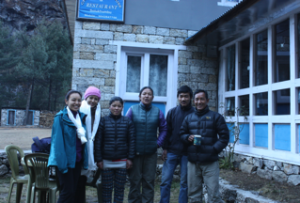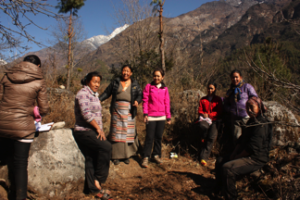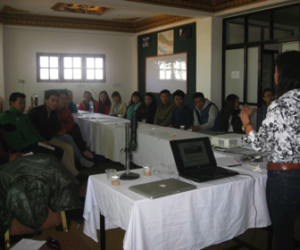Engaged Anthropology Grant: Pasang Yangjee Sherpa

Pasang Yangjee Sherpa is Lecturer in Anthropology at Pennsylvania State University. In 2011, while a doctoral candidate at Washington State University, she received a Dissertation Fieldwork Grant to aid research on ‘Sherpa Perceptions of Climate Change: Local Understandings of a Global Problem,’ supervised by Dr. John Bodley. In 2013 she was awarded the Engaged Anthropology Grant and returned to her fieldsite in Nepal’s Everest region to start conversations about institutions and researchers involving communities as equal partners in understanding and responding to climate change effects locally.
My doctoral research showed that despite several institutional responses to the effects of climate change being organized in the Everest region since 2004, the northern part called Khumbu and the southern part called Pharak, climate change is still a foreign concept to many. These institutional responses have narrowly focused on extreme events as climate change effects, which have limited our understanding of the wider climate change effects. In some cases, these responses also had unintended negative consequences putting lives in danger. The research also revealed that Sherpas are aware of and are experiencing environmental changes although differentially based on their socioeconomic and occupational backgrounds. Therefore, I developed this engagement project (December 2013 to January 2014) to start conversations about institutions and researchers involving communities as equal partners in understanding and responding to climate change effects locally.
Along with Medinee Prajapati and assistance from Prashidha Yonzon and Lhakpa Chamji, I conducted a seminar at the Environmental Graduates Himalaya premises with academic scholars, a seminar with the Sherwi Yondhen Tshokpa members, two workshops in Pharak, and informal discussions with community members. Two sets of low-cost weather monitoring stations were also installed in Pharak as pilot project to assess feasibility and usefulness. In this report, I focus on the two seminars and alter the names of my informants.

I started the seminar at EGH asking the attendees (40) to describe climate change, its impacts and what we could do to address them. After the discussion, I presented my research showing the need for community involvement in climate change studies as well as the need for the scientists and researchers to work collaboratively with community members as equal partners and stakeholders. Several times during the seminar, I found myself having to defend ethnographic methods and qualitative studies. The seminar concluded with discussions on the application of qualitative research to the study of climate change, which emerged as a topic during our discussion that requires scientific inquiry involving tools such as numbers, graphs and GIS maps.
A week later, the SYT seminar was organized and attended by 19 members from the Everest region, in their late teens or early to mid 20s, currently living in Kathmandu for higher studies. In this seminar, I presented my research questions, methodology, findings, conclusions and recommendations. After my presentation, I opened the floor for discussion.
Dawa from Pharak was the first to comment. He said, “I don’t believe in climate change. I think global warming is real but climate change seems like a phrase that is for others to use to do something.” Mingma from Khumbu then questioned, “Isn’t climate change a problem of the developed and developing countries?” Lhakpa also from Khumbu added, “Since most of the pollution is made by developed countries, what can someone like us do to mitigate the problem?” Instead of answering these questions, I asked everyone what was something they think they need to do and they could do. To this they replied:

“I think we can seek information and learn. Then share the knowledge with others. This is something we can all do,” said Lhakpa. He continued, “If we want to bring climate change awareness to people, we have to run a long-term campaign. It cannot be short-term programs. That will not work.”
Dawa reminded, “Before bringing programs, we should first be clear about what the problem really is. Then, we need to bring knowledge to the local people in practical ways. Our methods need to be different from past climate change activities.”
Mingma explained, “When any program is made or if someone or an institution goes into the community and continue to remind people about what is wrong or what is terrible and ask them to change their ways, of course people are going to be upset…If we need to bring programs to the locals, you have to first [build rapport]. Then only you need to tell them what the problem is. But you also need to offer them an alternative option instead of just telling them what they shouldn’t do. Even worse, people should not be reminded of the same problem over and over again.”
Dawa added, “It has to be in local language. If someone comes and talks in scientific language, it will mean nothing to the people because it will not be understandable and relatable.”

Looking at past climate change related institutional activities, we know that, said Lhakpa, “Just by bringing one or two speakers and speaking for just an hour or two about climate change is not going to make any difference. Especially if the speakers are using different languages and non-local terms, it will do nothing. Instead of that if we run a campaign [and develop course or curriculum at schools that might be more effective.] Also having brochures with pictures might be a good idea. When we were in village, I used to really like colorful brochures and took good care of them. Some people even stick them on their walls because they are good to look at. This way, the message continues to stay with them through the brochures.”
Observation of these seminars among academic scholars and the SYT members show that while both groups realize the need for [investigative] action, there are different perspectives in which such actions are imagined. Among the academic scholars engaged in anthropological sciences, based in Kathmandu and discussing national level climate change, quantitative research and meteorological data are emphasized whereas among educated Sherpa youths in Kathmandu, practical and locally sensitive programs are emphasized. The SYT seminar moreover also showed that Sherpa youths are concerned and informed about climate change issues. They are also actively engaged in their community and thus capable to contribute to climate change studies and programs as equal partners in ways other than how an international scientist, who had been to the Everest region to study Imja glacial lake described to me, a Pharak native, in 2011, “Of course, we will make sure the Sherpas are participating. They can carry the pipes to Imja Lake…”